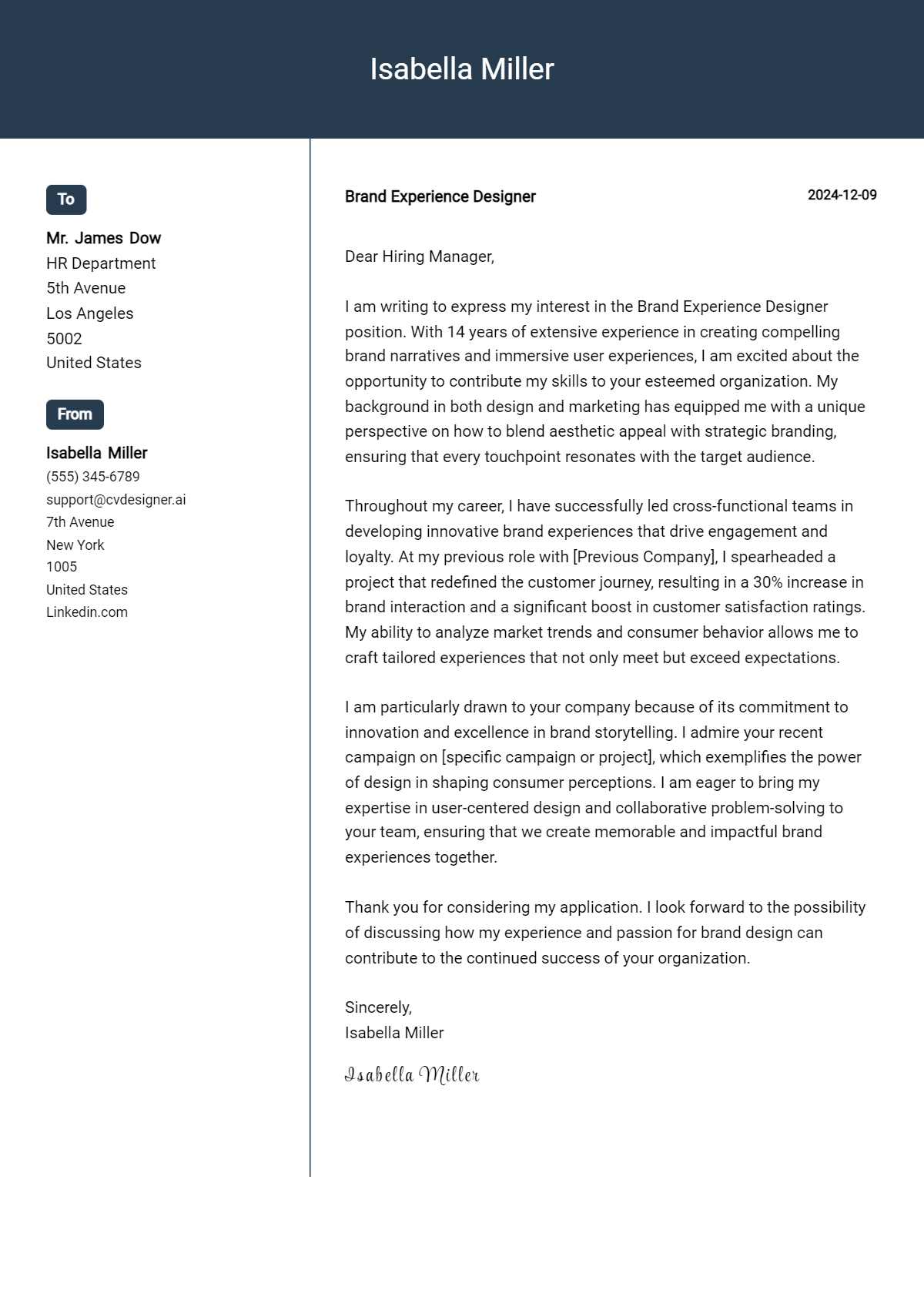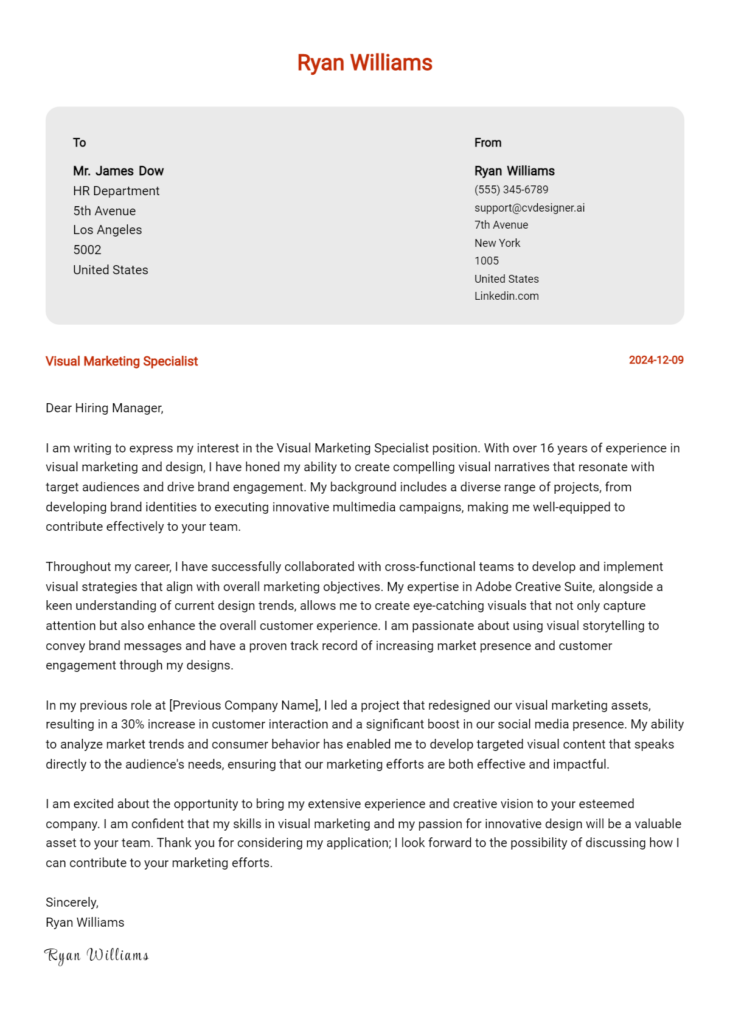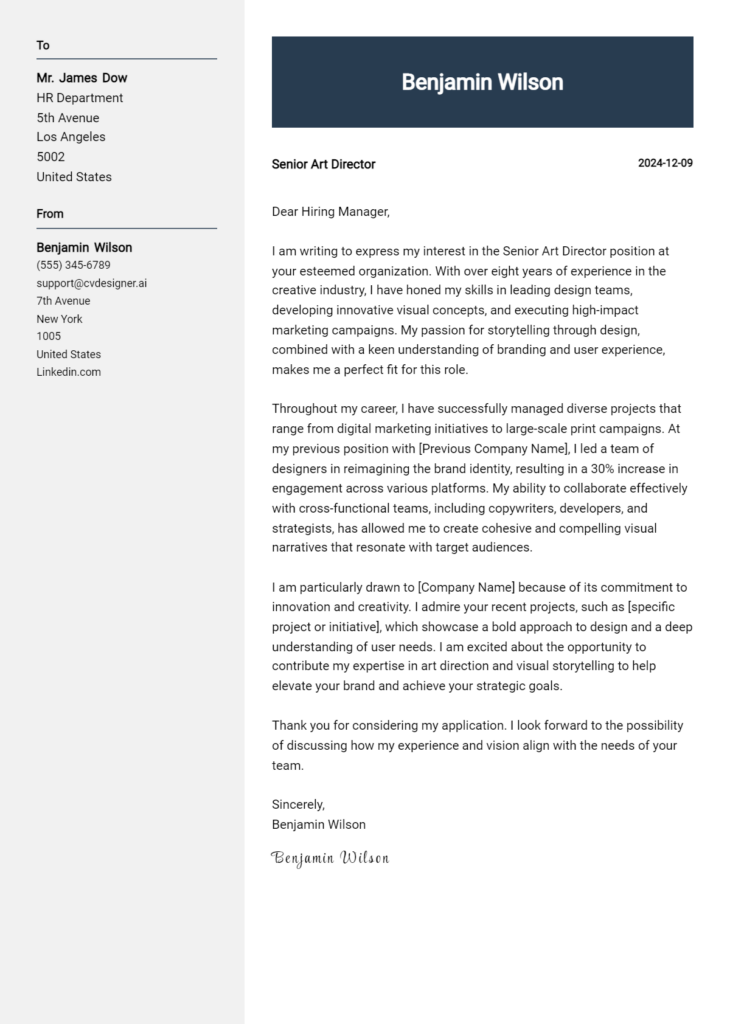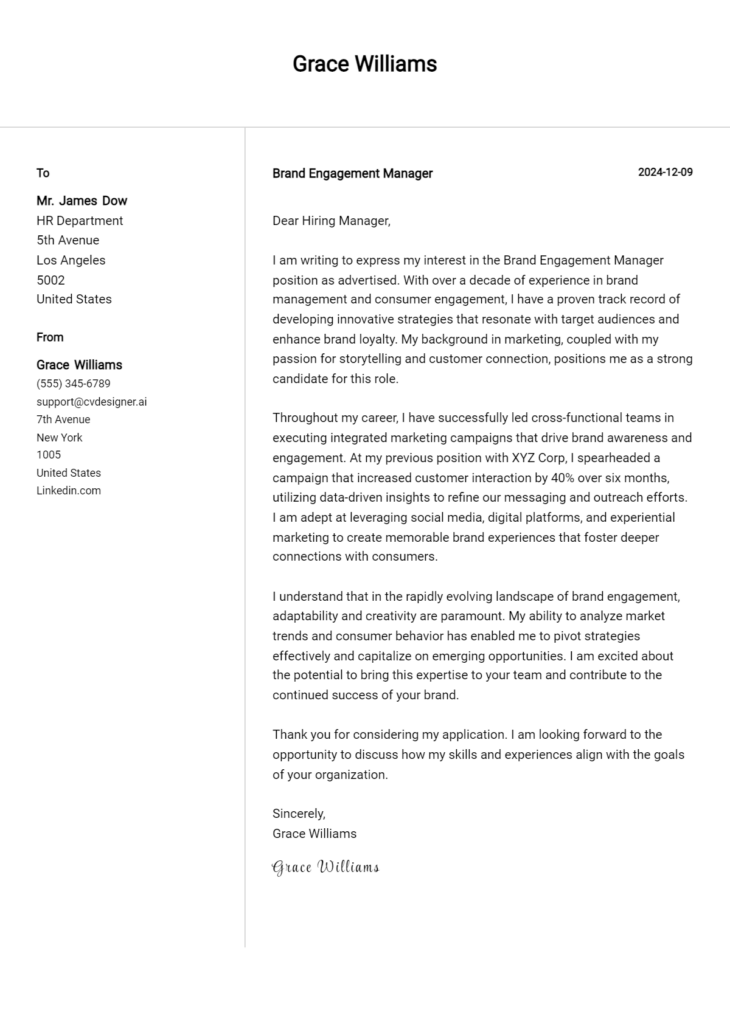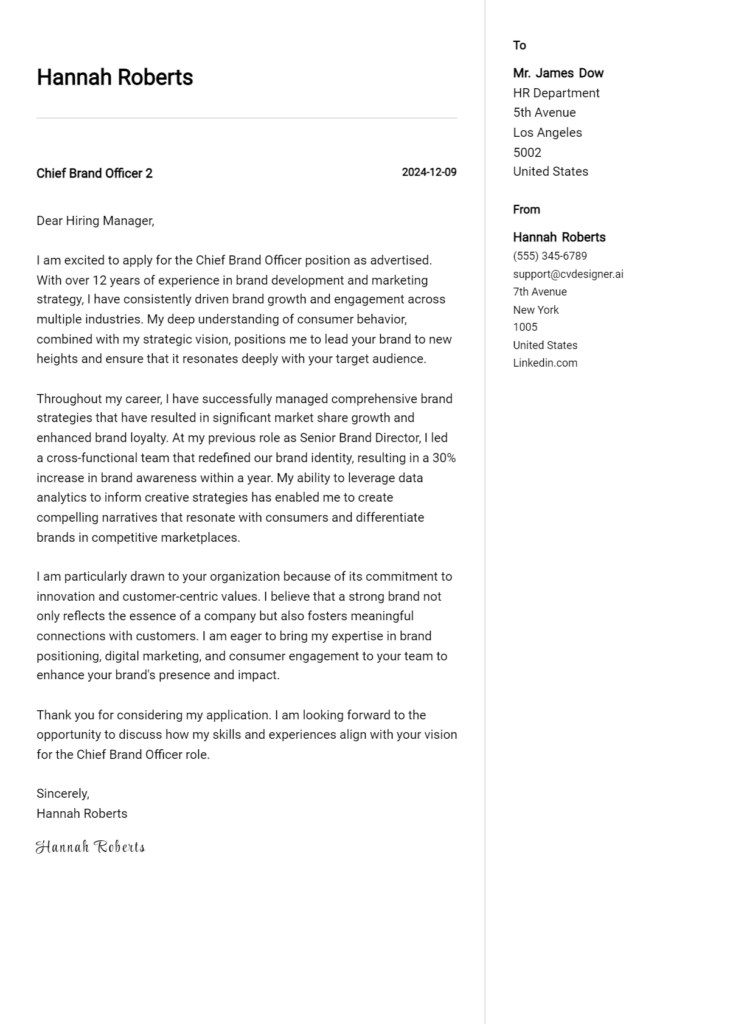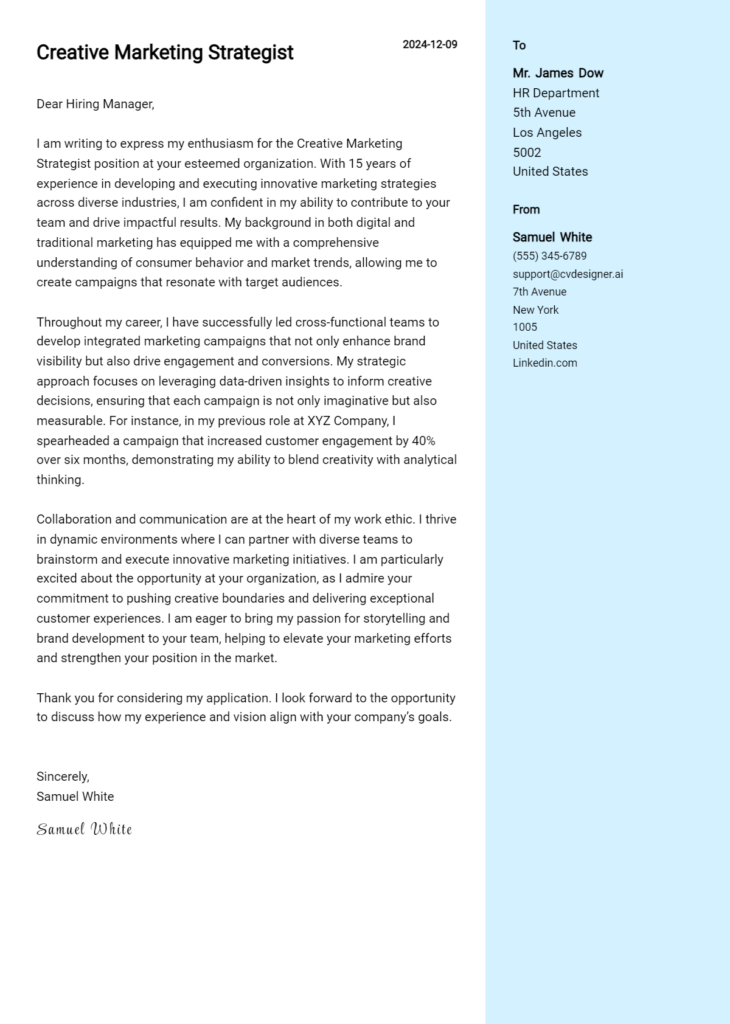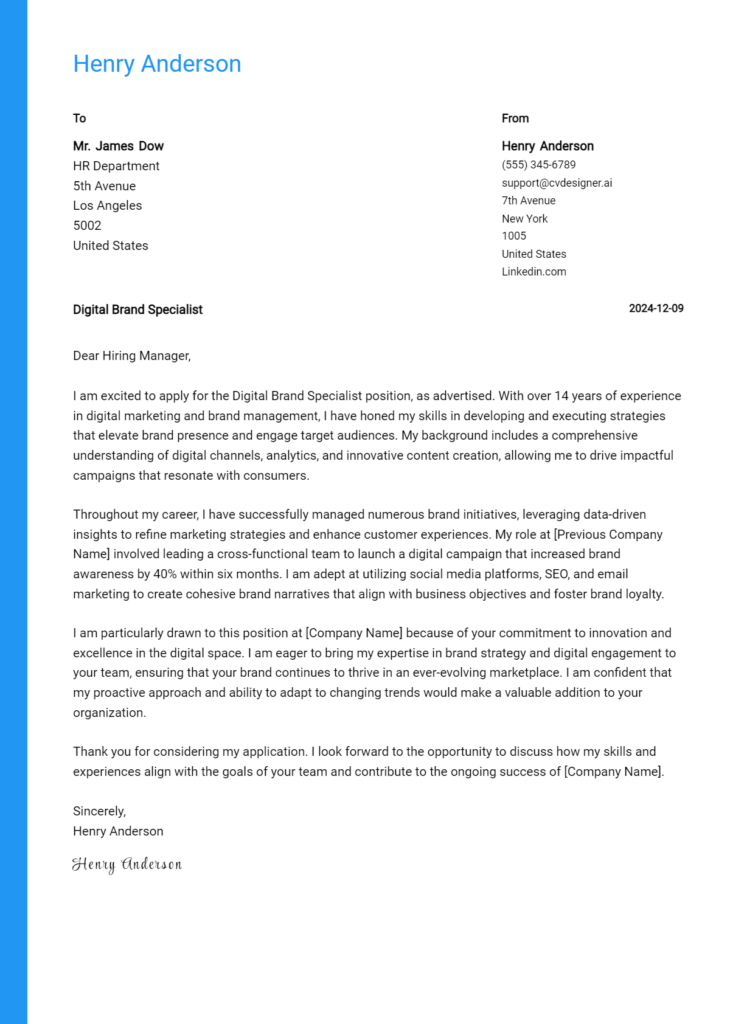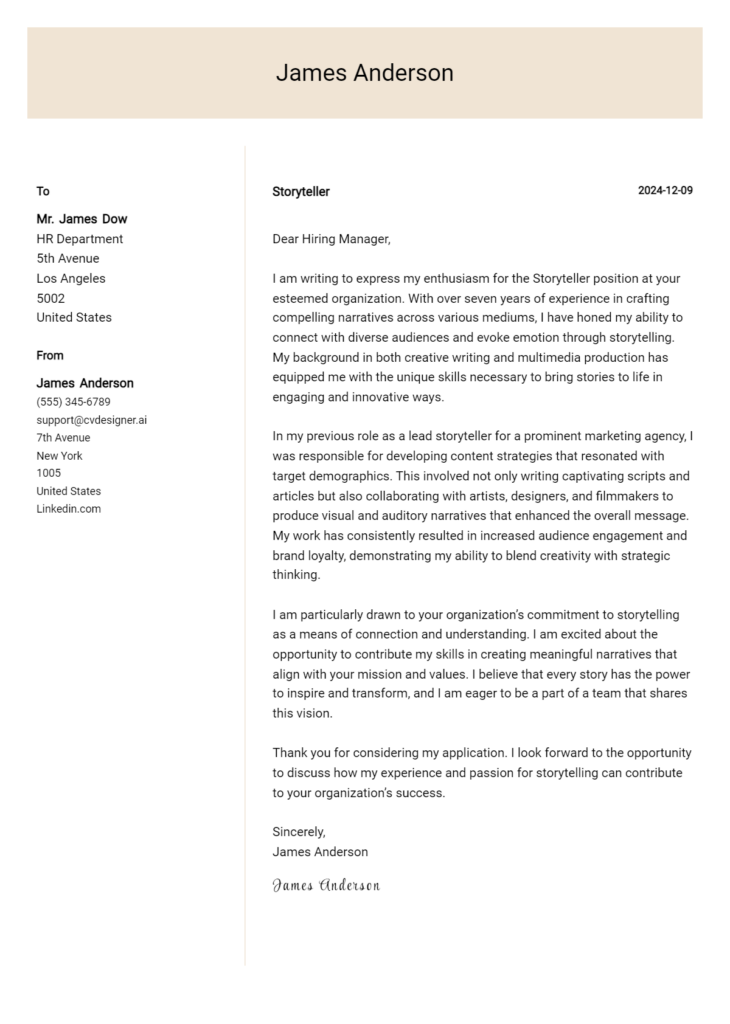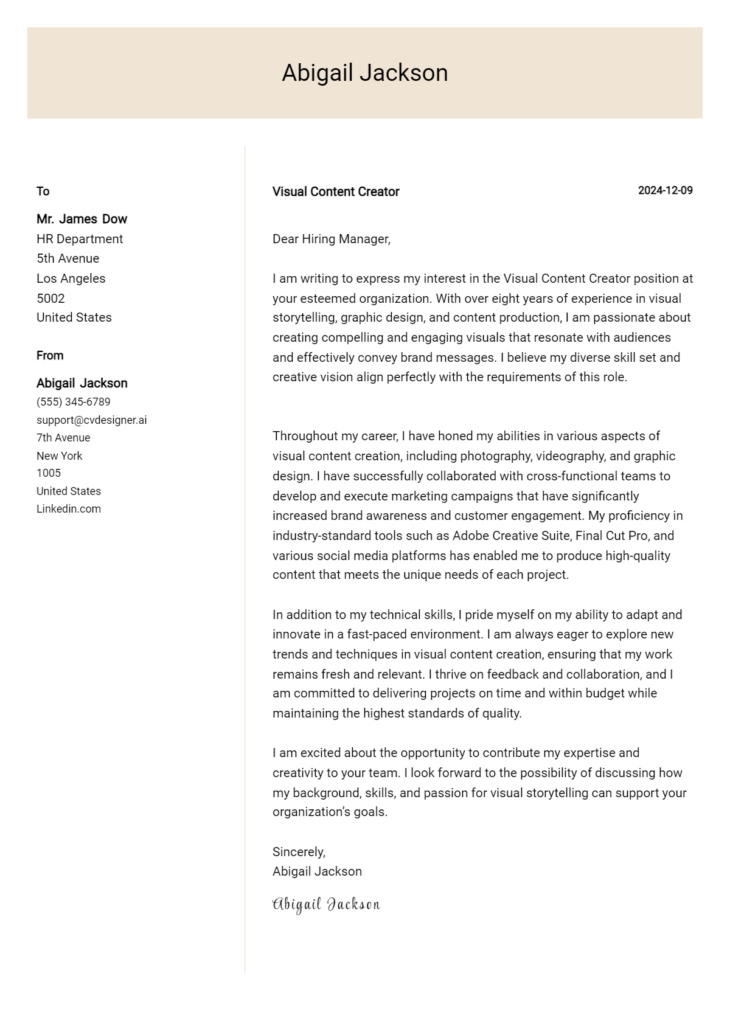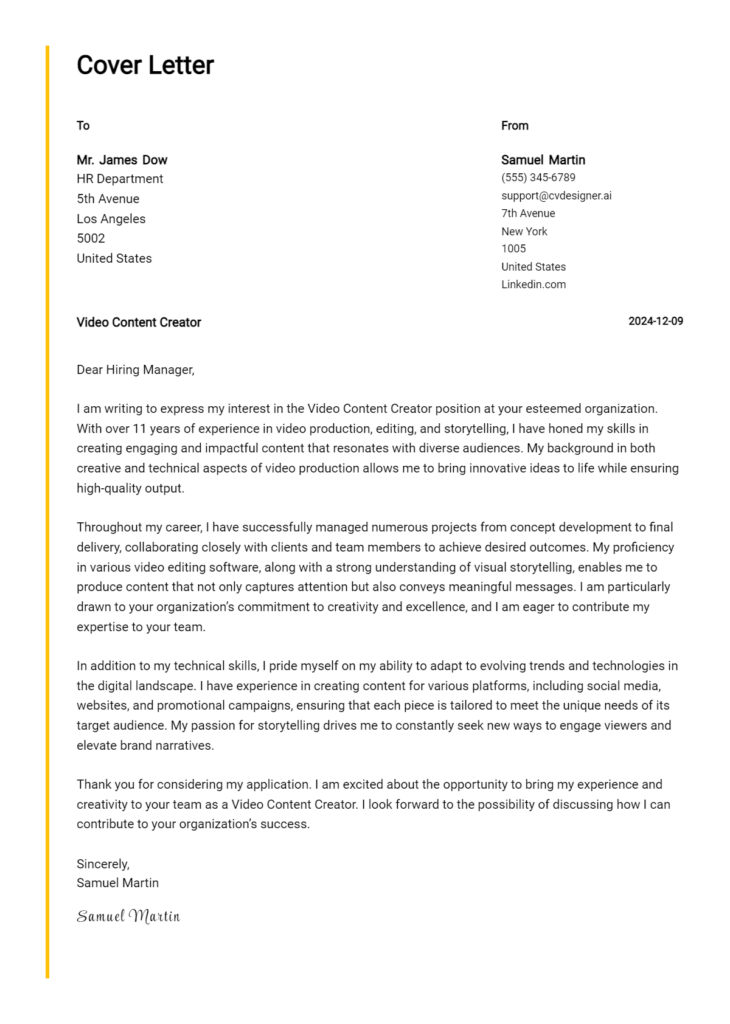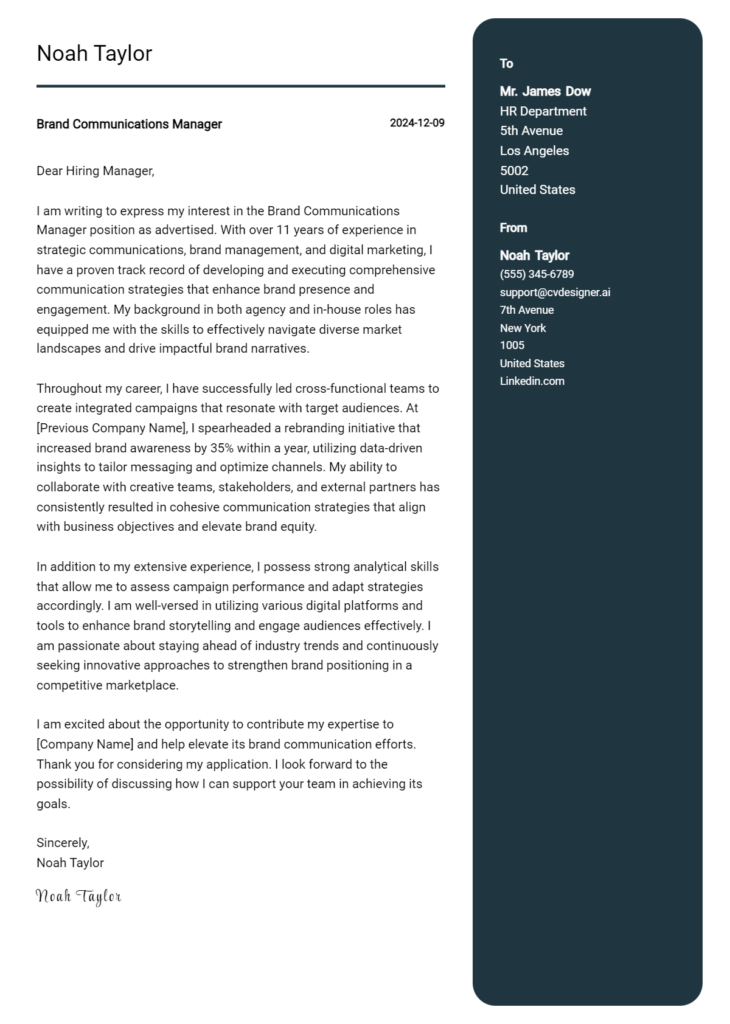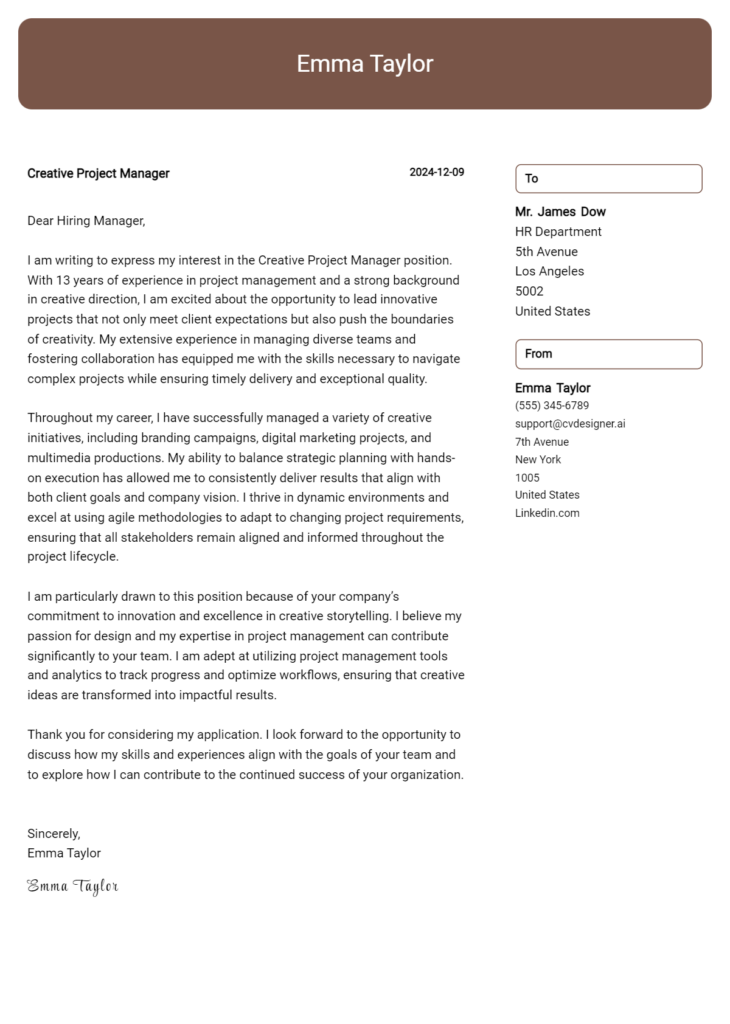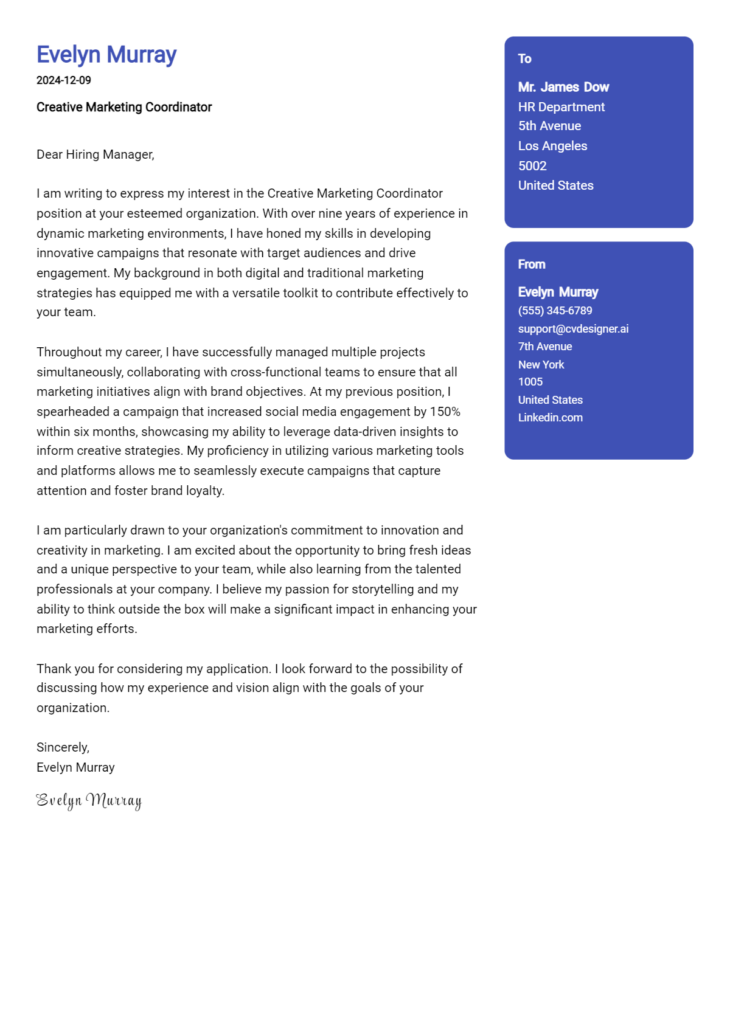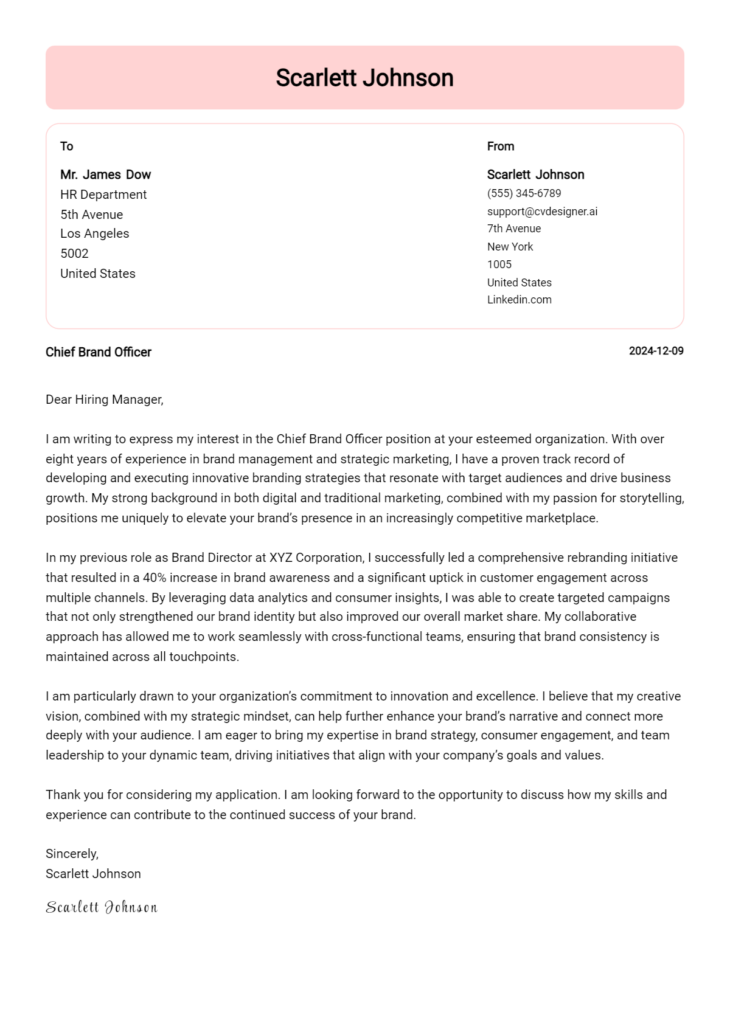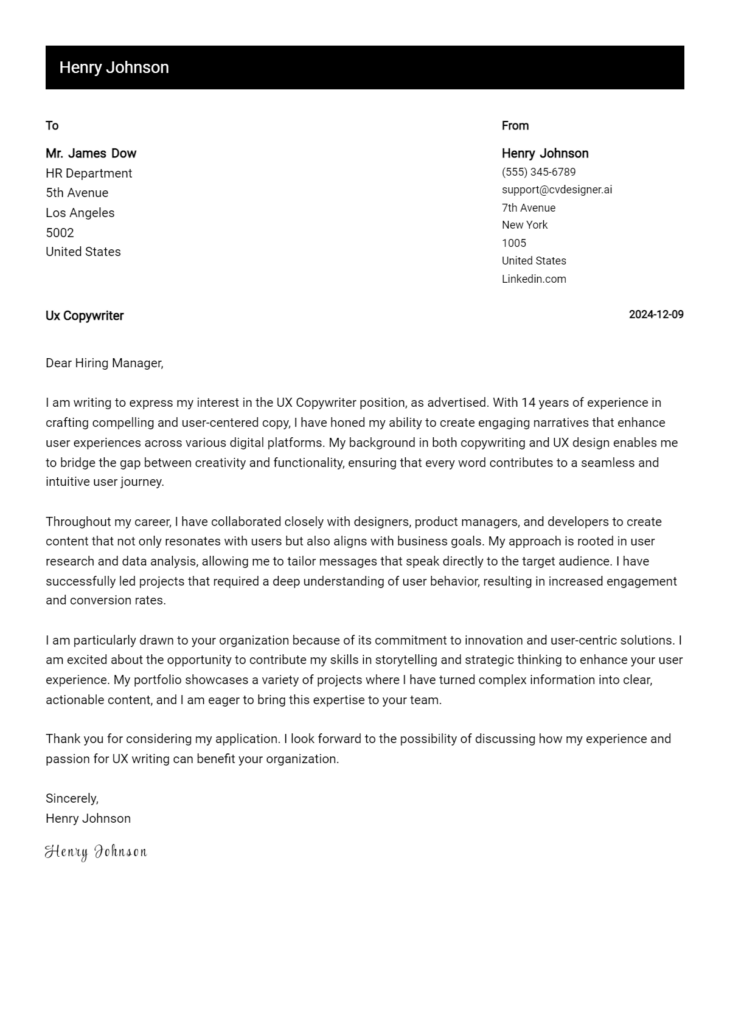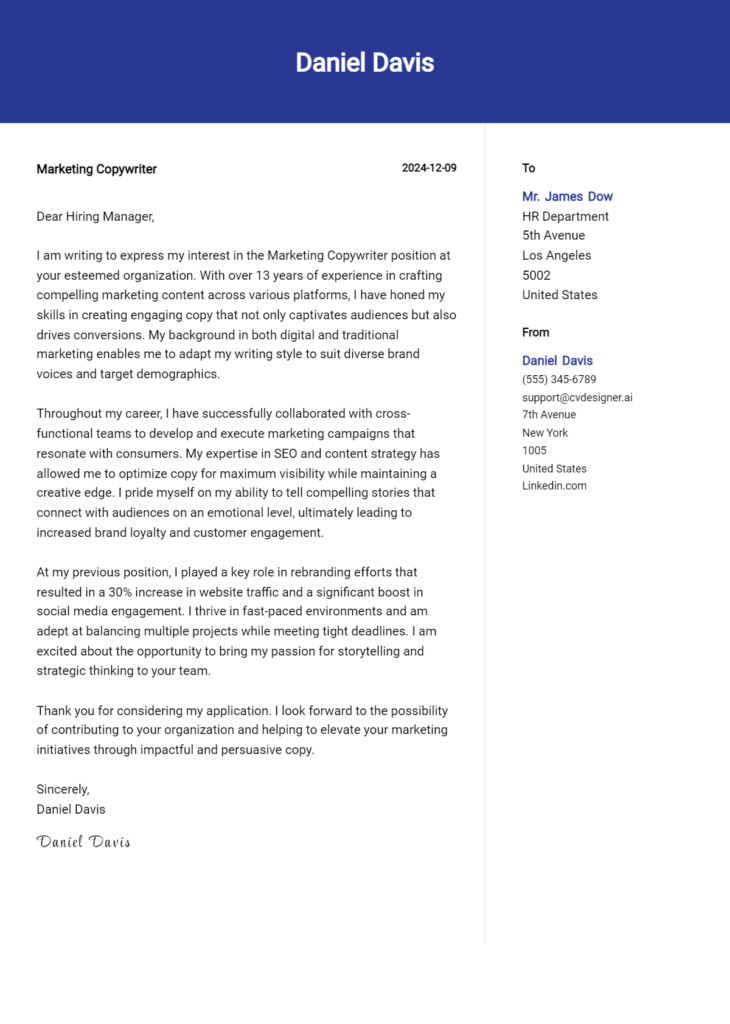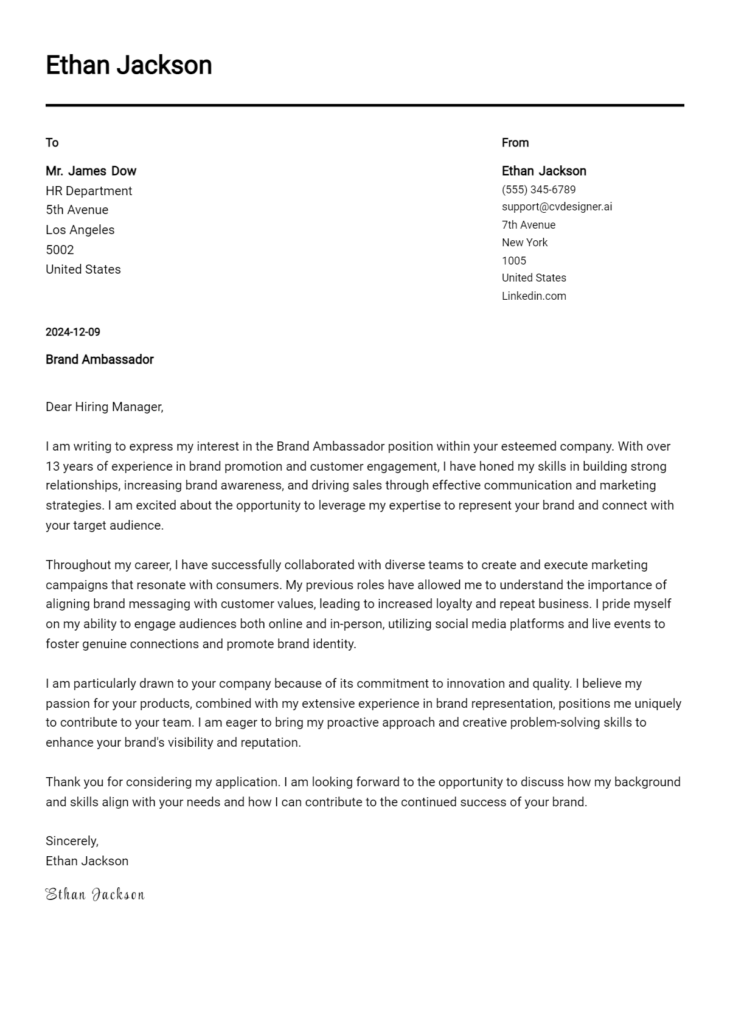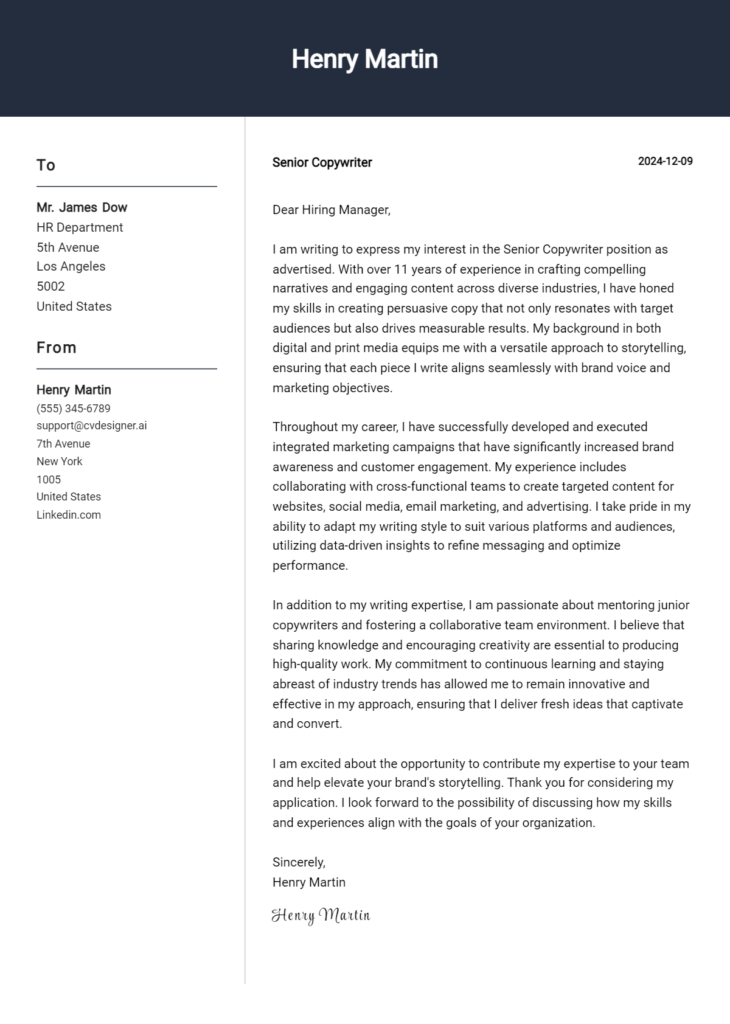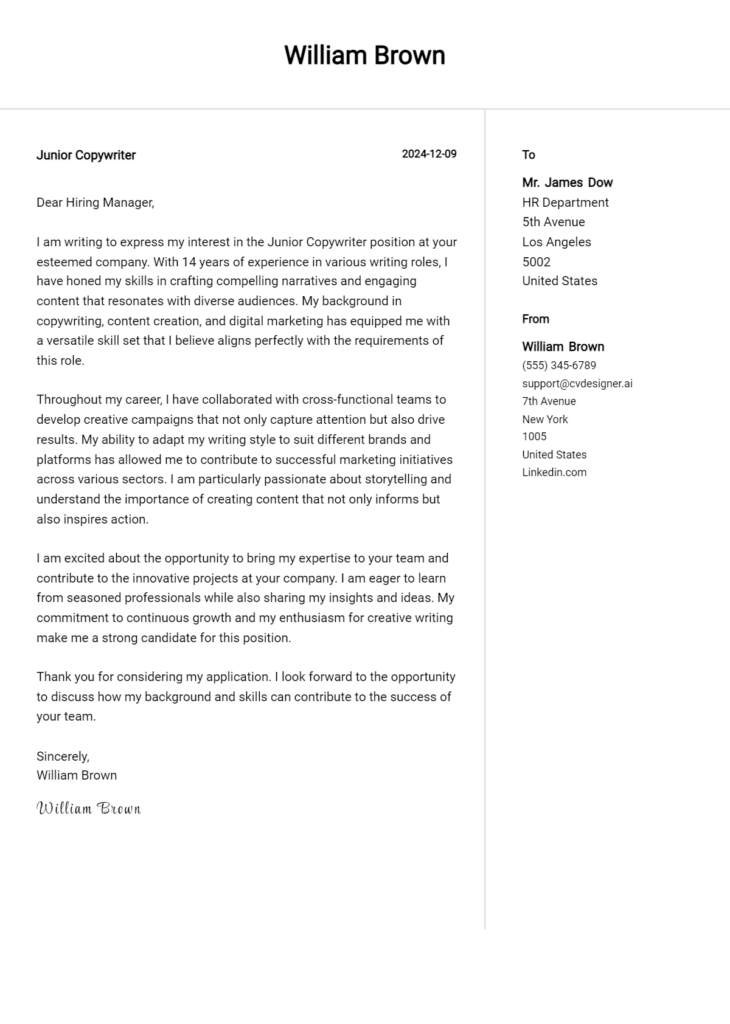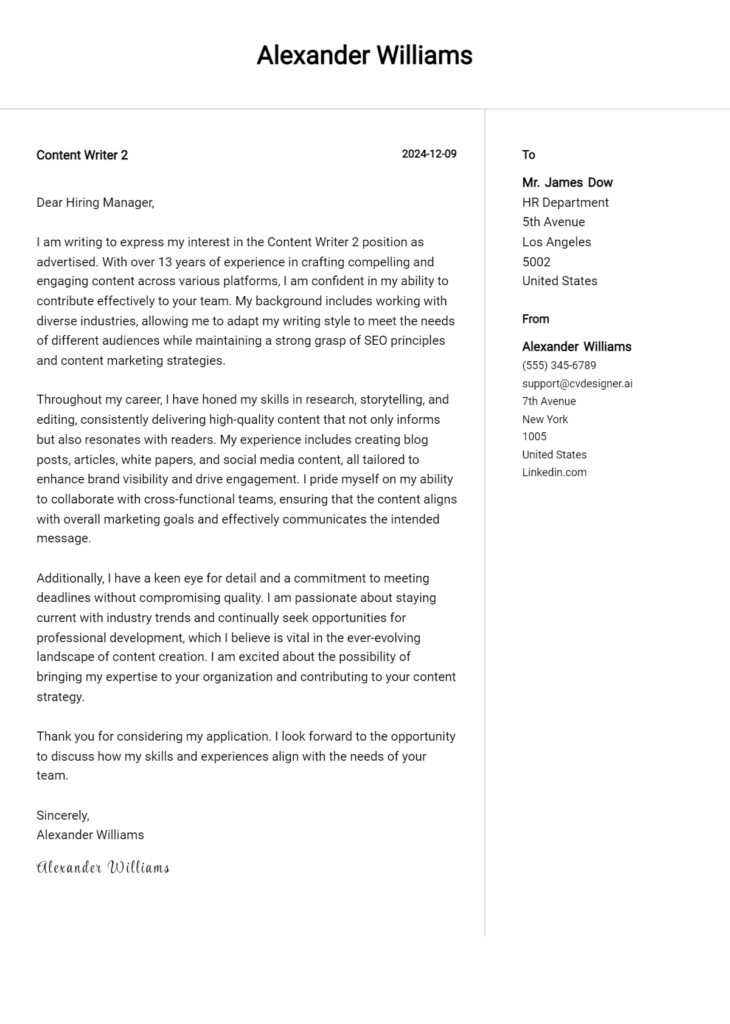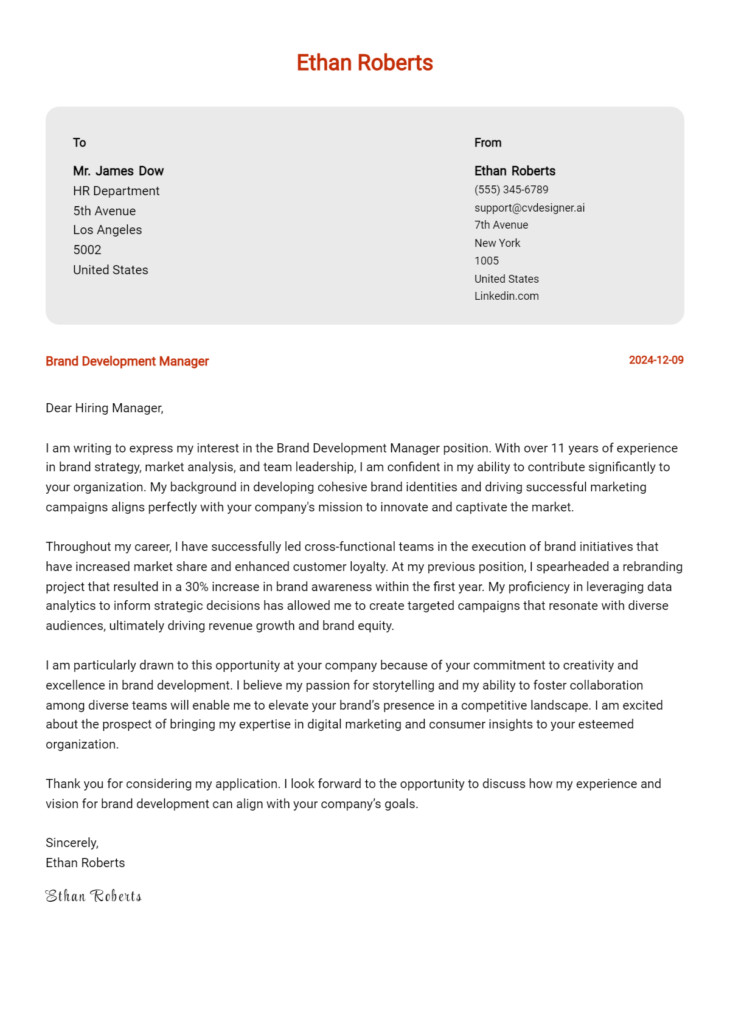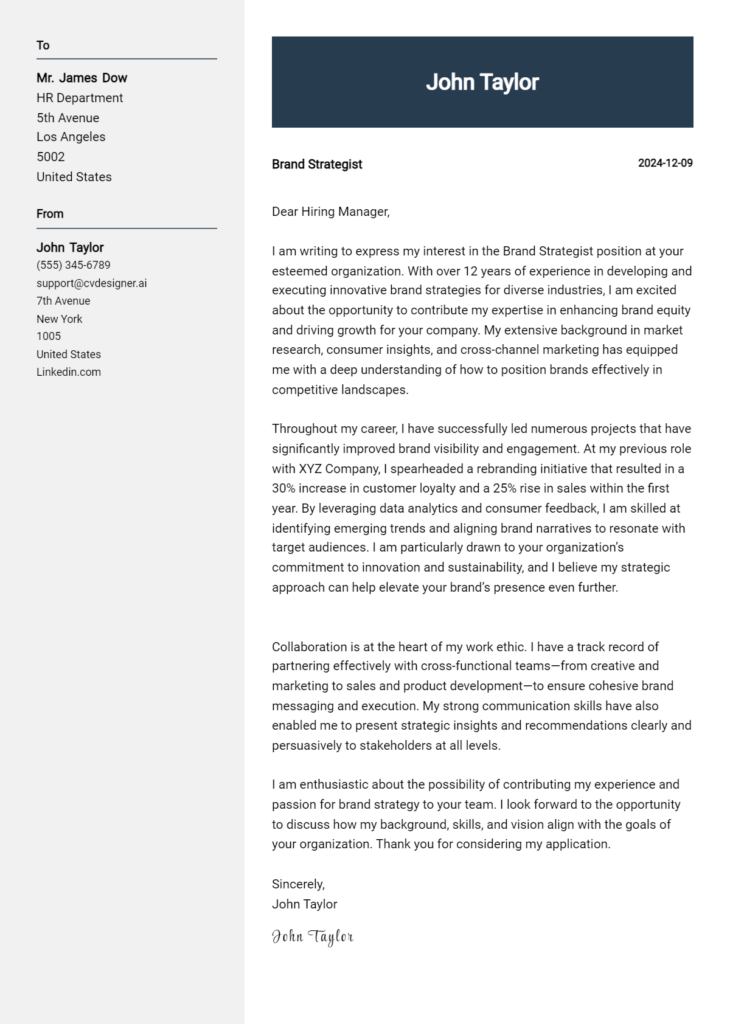Brand Experience Designer Cover Letter Examples
Explore additional Brand Experience Designer cover letter samples and guides and see what works for your level of experience or role.
How to Format a Brand Experience Designer Cover Letter?
Crafting a compelling cover letter is crucial for a Brand Experience Designer, as it goes beyond simply outlining your qualifications. The way you format and present your skills reflects your creativity, attention to detail, and understanding of user experience—all vital traits in this role. A well-structured cover letter not only captures the hiring manager's attention but also demonstrates your ability to curate exceptional brand experiences through thoughtful design and communication.
In this guide, we'll delve into the key components of an effective cover letter, providing insights tailored to Brand Experience Designers to help you create a standout document.
We will focus on the essential elements of a professional cover letter, including:
- Cover Letter Header
- Cover Letter Greeting
- Cover Letter Introduction
- Cover Letter Body
- Cover Letter Closing
Each section is critical in showcasing your qualifications and creative flair. Let’s break down each part and explore how to make your Brand Experience Designer cover letter shine.
Importance of the Cover Letter Header for a Brand Experience Designer
The cover letter header is a critical component of your application as a Brand Experience Designer. It sets the tone for your correspondence and provides essential information that establishes your professionalism and attention to detail. A well-structured header should include your contact information, the date, and the recipient's details, ensuring clarity and ease of communication. This initial impression can significantly impact how your application is perceived, highlighting your design sensibility and organizational skills.
Strong Example
Jane Doe 123 Creative Lane Design City, CA 90210 jane.doe@email.com (123) 456-7890 October 1, 2023 John Smith Hiring Manager Innovative Brands Inc. 456 Marketing Ave Brand Town, CA 90211
Weak Example
jane doe email: jane.doe@email.com Date: 10/01/2023 Hi there,
The Importance of a Cover Letter Greeting
The greeting of your cover letter serves as the first impression for the hiring manager and is crucial in setting the tone for the rest of your letter. A well-crafted greeting demonstrates professionalism and shows that you have taken the time to personalize your application. By addressing the hiring manager directly, you establish a connection and signal that you are genuinely interested in the position. To avoid generic greetings that can come off as insincere, it's beneficial to research the recipient's name, which can often be found on the company’s website or LinkedIn. A personalized greeting not only captures attention but also reflects your commitment to the brand and its values.
Strong Greeting Example
Dear Ms. Johnson,
Weak Greeting Example
To Whom It May Concern,
The Importance of a Captivating Cover Letter Introduction for a Brand Experience Designer
A well-crafted cover letter introduction is crucial for a Brand Experience Designer, as it serves as the first impression to the hiring manager. This opening paragraph should not only grab attention but also convey genuine interest in the role and showcase relevant skills or achievements that align with the company’s objectives. An engaging introduction sets the tone for the rest of the cover letter, making it clear why the candidate is the ideal fit for the role. Below are examples of both strong and weak cover letter introductions to illustrate the impact of a compelling opening.
Strong Example
Dear [Hiring Manager's Name], As a passionate Brand Experience Designer with over five years of experience in creating immersive brand narratives, I was thrilled to discover the opportunity at [Company Name]. My background in user-centered design and my successful project leading a rebranding initiative that increased customer engagement by 30% align perfectly with your vision of enhancing brand loyalty and creating unforgettable customer experiences. I am eager to bring my unique blend of creativity and strategic thinking to your team and help elevate [Company Name]'s brand presence in the market.
Weak Example
To Whom It May Concern, I am writing to apply for the Brand Experience Designer position. I have some experience in design and have worked on various projects. I think I could do a good job for your company. I hope you will consider my application.
Purpose of the Cover Letter Body for a Brand Experience Designer
The body of a cover letter for a Brand Experience Designer serves as a crucial platform for candidates to articulate their unique skills, relevant experiences, and the value they can bring to a prospective employer. This section should not only highlight the candidate's design expertise but also connect their past projects and accomplishments to the specific needs and goals of the company they are applying to. By providing tangible examples of successful brand experiences they've crafted, candidates can effectively demonstrate their ability to enhance customer engagement, drive brand loyalty, and contribute to the overall success of the brand.
Strong Example
Dear [Hiring Manager's Name], I am excited to apply for the Brand Experience Designer position at [Company Name]. In my previous role at [Previous Company], I led a rebranding project that increased customer engagement by 40% through an immersive digital campaign. By collaborating with cross-functional teams, I developed a cohesive brand narrative that resonated with our target audience, resulting in a 25% increase in online sales within six months. I am passionate about creating meaningful brand experiences and believe my skills in user-centered design and storytelling can greatly benefit [Company Name] as it continues to innovate in the marketplace. Sincerely, [Your Name]
Weak Example
Dear [Hiring Manager's Name], I want to apply for the Brand Experience Designer job. I have done some design work in the past, and I think I can help your company. I worked on a few projects, but I can't remember the details. I believe I am a creative person and I enjoy designing things. I hope to get a chance to work with you. Best, [Your Name]
The Importance of the Cover Letter Closing for a Brand Experience Designer
The closing paragraph of a cover letter is crucial for summarizing your qualifications, reiterating your enthusiasm for the position, and encouraging the hiring manager to take the next steps, such as reviewing your resume or scheduling an interview. A strong closing leaves a lasting impression and reinforces your fit for the role, while a weak closing may fail to convey your eagerness or professionalism.
Strong Example
Thank you for considering my application for the Brand Experience Designer position. With my expertise in creating immersive brand experiences and my passion for innovative design, I am excited about the opportunity to contribute to your team. I look forward to the possibility of discussing how my background aligns with your goals. Please feel free to review my resume for additional details, and I would be thrilled to schedule an interview at your earliest convenience.
Weak Example
Thanks for reading my letter. I hope you like my resume. I would like to work for you, so let me know if you want to talk.
Crafting an effective cover letter for a Brand Experience Designer is essential for standing out in a competitive job market. This role demands a unique blend of creativity and technical skills, alongside a deep understanding of user experience and design principles. Your cover letter should highlight your problem-solving abilities, knowledge of the Software Development Life Cycle (SDLC), teamwork experiences, and an unwavering passion for continuous learning. Here are five detailed tips to help you create a compelling cover letter that showcases these important attributes.
Tips for Writing an Effective Cover Letter
Showcase Your Technical Skills
Begin your cover letter by emphasizing your technical proficiencies relevant to brand experience design. Mention any design software, coding languages, or methodologies you are skilled in, such as Adobe Creative Suite, Sketch, or Figma. Provide specific examples of how you have applied these tools in previous projects to enhance brand experience.Highlight Problem-Solving Abilities
Use your cover letter to demonstrate your problem-solving skills. Describe a challenging project you worked on and explain how you identified issues and implemented effective solutions. This not only shows your analytical abilities but also reflects your approach to enhancing user experiences through thoughtful design.Emphasize Your Knowledge of SDLC
A thorough understanding of the Software Development Life Cycle (SDLC) is crucial for a Brand Experience Designer. In your cover letter, briefly outline your familiarity with each stage of the SDLC and how it relates to your design process. Discuss how your contributions have improved communication and collaboration between design and development teams.Illustrate Teamwork Experiences
Brand experience design often requires collaboration with cross-functional teams. Highlight your teamwork experiences by providing examples of successful projects where you worked closely with other designers, marketers, or developers. Emphasize your ability to communicate effectively and how your collaborative efforts led to successful outcomes.Communicate Your Passion for Continuous Learning
The design field is ever-evolving, making continuous learning essential. Share your commitment to professional development by mentioning any courses, workshops, or conferences you have attended. Discuss how you stay updated on the latest design trends and technologies, and express your enthusiasm for applying new knowledge to your work.
By following these tips and tailoring your cover letter to reflect your unique experiences and skills, you will be well on your way to making a strong impression. For additional assistance, consider exploring cover letter templates or using a cover letter builder to streamline your writing process.
Common Mistakes to Avoid in a Brand Experience Designer Cover Letter
Crafting a compelling cover letter is crucial for standing out in the competitive field of brand experience design. Avoiding common pitfalls can enhance your chances of making a lasting impression. Here are some frequent mistakes and tips for steering clear of them:
Generic Content: Sending a one-size-fits-all cover letter can hurt your chances. Tailor your letter to the specific company and role by incorporating details about their brand and values.
Lack of Specific Examples: Failing to provide concrete examples of your work can leave your skills unsubstantiated. Highlight specific projects or experiences that demonstrate your design process and impact.
Overly Formal Language: Using stiff, formal language can make your letter sound impersonal. Opt for a conversational tone that reflects your personality and enthusiasm for the role.
Ignoring the Format: Not adhering to proper cover letter format can detract from your professionalism. Follow guidelines for layout and structure, which you can find in this cover letter format guide.
Typos and Grammatical Errors: Mistakes in spelling and grammar can undermine your credibility. Always proofread your letter and consider using tools or asking peers for feedback.
Focusing on Yourself Too Much: While showcasing your skills is important, emphasize how you can add value to the company. Align your expertise with their needs to demonstrate your potential contributions.
Neglecting to Include a Call to Action: Failing to invite the reader to take the next step can leave your letter feeling incomplete. Conclude with a strong call to action, expressing your eagerness to discuss your fit for the role.
By avoiding these common mistakes and taking the time to craft a thoughtful letter, you can significantly improve your chances of landing an interview. For further inspiration, check out these cover letter examples.
Cover Letter FAQs for Brand Experience Designer
What should I include in my cover letter as a Brand Experience Designer?
As a Brand Experience Designer, your cover letter should highlight your unique blend of creativity and strategic thinking. Start with a brief introduction about yourself and your passion for brand storytelling. Include specific examples of projects where you enhanced customer engagement or improved brand perception, showcasing your design process and outcomes. Mention your proficiency with design tools and methodologies relevant to the role, as well as your understanding of user experience principles. Finally, express your enthusiasm for the company and how your vision aligns with their brand values.
How can I demonstrate my design skills in my cover letter?
To effectively demonstrate your design skills in your cover letter, use descriptive language to articulate your design philosophy and approach. Reference specific projects where your design work had a measurable impact, such as increased user engagement or brand awareness. If applicable, mention any awards or recognitions you've received for your work. Consider including links to your portfolio or specific case studies that showcase your best designs. This not only provides evidence of your skills but also allows potential employers to see your style and versatility.
Should I tailor my cover letter for each application?
Absolutely! Tailoring your cover letter for each application is crucial in standing out in a competitive field like brand experience design. Research the company’s mission, values, and recent projects to tailor your message accordingly. Highlight how your skills and experiences align specifically with the job description and the company’s brand objectives. By demonstrating a clear understanding of the brand and articulating how you can contribute to their goals, you present yourself as a strong candidate who is genuinely interested in the opportunity.
How long should my cover letter be?
Your cover letter should typically be one page long, consisting of three to four concise paragraphs. Aim for around 250-300 words. This length allows you to provide a compelling overview of your qualifications without overwhelming the reader. Make each word count by focusing on relevant experiences, skills, and achievements that align with the job description. Remember to maintain a clear structure: an engaging introduction, a body that details your qualifications and experiences, and a strong conclusion that reiterates your interest in the position and invites the employer to review your portfolio.
Build your Cover Letter in minutes
Use an AI-powered cover letter builder and have your letter done in 5 minutes. Just select your template and our software will guide you through the process.

